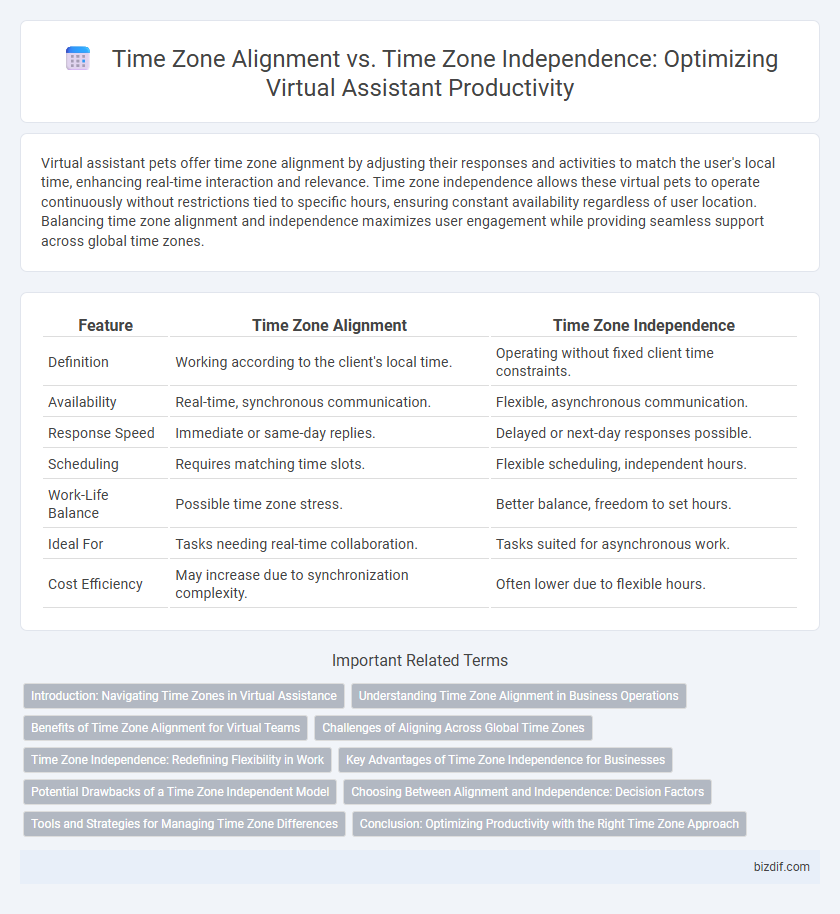Virtual assistant pets offer time zone alignment by adjusting their responses and activities to match the user's local time, enhancing real-time interaction and relevance. Time zone independence allows these virtual pets to operate continuously without restrictions tied to specific hours, ensuring constant availability regardless of user location. Balancing time zone alignment and independence maximizes user engagement while providing seamless support across global time zones.
Table of Comparison
| Feature | Time Zone Alignment | Time Zone Independence |
|---|---|---|
| Definition | Working according to the client's local time. | Operating without fixed client time constraints. |
| Availability | Real-time, synchronous communication. | Flexible, asynchronous communication. |
| Response Speed | Immediate or same-day replies. | Delayed or next-day responses possible. |
| Scheduling | Requires matching time slots. | Flexible scheduling, independent hours. |
| Work-Life Balance | Possible time zone stress. | Better balance, freedom to set hours. |
| Ideal For | Tasks needing real-time collaboration. | Tasks suited for asynchronous work. |
| Cost Efficiency | May increase due to synchronization complexity. | Often lower due to flexible hours. |
Introduction: Navigating Time Zones in Virtual Assistance
Time zone alignment in virtual assistance ensures scheduled meetings and real-time collaboration occur seamlessly across global teams, minimizing delays and misunderstandings. Time zone independence offers flexibility, allowing assistants to operate asynchronously, supporting tasks without requiring simultaneous availability. Effective virtual assistance balances these approaches to optimize productivity and communication across diverse geographic locations.
Understanding Time Zone Alignment in Business Operations
Time zone alignment in business operations ensures synchronized working hours, enhancing real-time communication and collaboration among distributed teams. This alignment minimizes delays in decision-making and supports seamless customer service across different regions. Adopting a time zone-aware scheduling system optimizes productivity and operational efficiency in global virtual assistant deployments.
Benefits of Time Zone Alignment for Virtual Teams
Time zone alignment in virtual teams enhances real-time communication and collaboration, reducing delays and misunderstandings. Teams synchronized within similar working hours improve productivity by enabling immediate feedback and quicker decision-making. This alignment also fosters stronger team cohesion and trust through more consistent and personal interactions.
Challenges of Aligning Across Global Time Zones
Managing virtual assistants across global time zones presents challenges such as scheduling meetings, ensuring real-time communication, and coordinating workflows without delays. Time zone alignment requires synchronization of work hours, which can limit flexibility and increase operational complexity. Conversely, time zone independence allows asynchronous collaboration but may lead to delays in response times and reduced team cohesion.
Time Zone Independence: Redefining Flexibility in Work
Time zone independence empowers virtual assistants to operate without geographical or temporal constraints, enhancing productivity and accessibility across global markets. By decoupling work schedules from specific time zones, businesses achieve continuous workflow and seamless client interactions, boosting efficiency. This model supports diverse talent pools and promotes a flexible work culture tailored to individual peak performance periods.
Key Advantages of Time Zone Independence for Businesses
Time zone independence allows businesses to operate seamlessly across global markets by enabling employees and virtual assistants to work asynchronously without delays or coordination challenges. This flexibility boosts productivity and accelerates project timelines as tasks are completed around the clock, leveraging a 24-hour workflow. Moreover, time zone independence enhances customer service availability, providing clients worldwide with timely support and reducing response times dramatically.
Potential Drawbacks of a Time Zone Independent Model
A time zone independent model for virtual assistants can lead to challenges in scheduling and real-time communication due to asynchronous availability across regions. Users may experience delays or misalignment in task execution, reducing the assistant's effectiveness in time-sensitive scenarios. Furthermore, lack of synchronized time zone settings can cause confusion in reminders, notifications, and deadline management, impacting overall user satisfaction.
Choosing Between Alignment and Independence: Decision Factors
Choosing between time zone alignment and time zone independence for virtual assistants depends on factors such as user location distribution, collaboration requirements, and service availability. Time zone alignment enhances real-time communication and task synchronization across teams sharing similar time zones. Time zone independence offers greater flexibility and continuous support, particularly for global operations requiring 24/7 availability without geographic constraints.
Tools and Strategies for Managing Time Zone Differences
Tools for managing time zone differences include world clocks, scheduling apps like Google Calendar and Microsoft Outlook, and platforms such as World Time Buddy that offer real-time overlap and meeting suggestions. Strategies involve establishing clear communication protocols, using asynchronous collaboration tools like Slack or Trello, and setting common core working hours to ensure temporal alignment. Employing these approaches enhances productivity by minimizing scheduling conflicts and fostering seamless coordination across global teams.
Conclusion: Optimizing Productivity with the Right Time Zone Approach
Selecting the right time zone strategy directly impacts virtual assistant productivity, with time zone alignment enhancing real-time collaboration and responsiveness. Conversely, time zone independence promotes flexible work hours and can drive continuous progress across global markets. Balancing these approaches according to team needs and client demands optimizes workflow efficiency and ensures timely project delivery.
Time zone alignment vs Time zone independence Infographic

 bizdif.com
bizdif.com